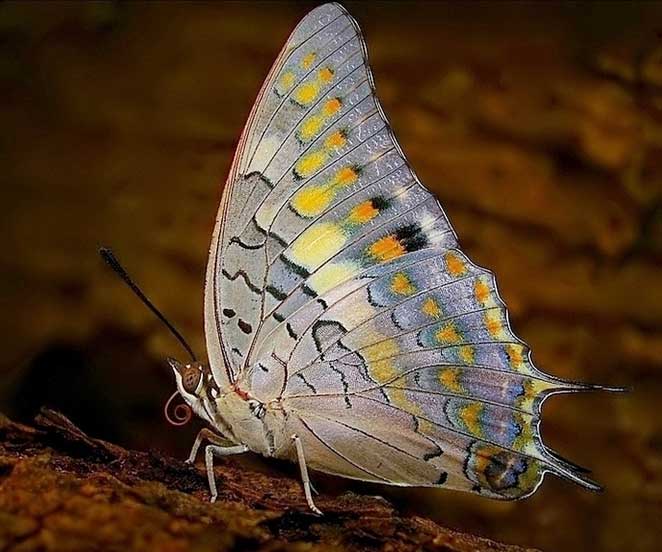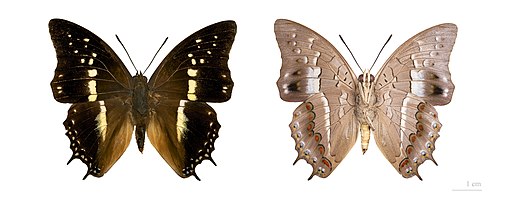
Charaxes solon (*)
Superregnum: Eukaryota
Cladus: Unikonta
Cladus: Opisthokonta
Cladus: Holozoa
Regnum: Animalia
Subregnum: Eumetazoa
Cladus: Bilateria
Cladus: Nephrozoa
Cladus: Protostomia
Cladus: Ecdysozoa
Cladus: Panarthropoda
Phylum: Arthropoda
Subphylum: Hexapoda
Classis: Insecta
Cladus: Dicondylia
Subclassis: Pterygota
Cladus: Metapterygota
Infraclassis: Neoptera
Cladus: Eumetabola
Cladus: Endopterygota
Superordo: Panorpida
Cladus: Amphiesmenoptera
Ordo: Lepidoptera
Subordo: Glossata
Cladus: Coelolepida
Cladus: Myoglossata
Cladus: Neolepidoptera
Infraordo: Heteroneura
Cladus: Eulepidoptera
Cladus: Ditrysia
Cladus: Apoditrysia
Cladus: Obtectomera
Superfamilia: Papilionoidea
Familia: Nymphalidae
Subfamilia: Charaxinae
Tribus: Charaxini
Genus: Charaxes
Species: Charaxes solon
Subspecies: C. s. brevis – C. s. catulus – C. s. cerynthus – C. s. cunctator – C. s. echo – C. s. hannibal – C. s. iliona – C. s. jordani – C. s. lampedo – C. s. mangolianus – C. s. obscurus – C. s. orchomenus – C. s. raidhaka – C. s. setsuroi – C. s. solon – C. s. sulphureus – C. s. sumatranus
Name
Charaxes solon Fabricius, 1793
Synonyms
Papilio solon Fabricius, 1793
References
Hanafusa, H. 1989: New species and subspecies of butterflies from South East Asia. Futao 1: 3–10. Reference page.
Vernacular names
বাংলা: রেশমবাজ
English: Black Rajah
தமிழ்: கறுப்புச் சிறகன்
Charaxes solon, the black rajah,[2][3] is a butterfly species found in tropical Asia. It belongs to the Charaxinae (rajahs and nawabs) in the brush-footed butterfly family (Nymphalidae).[1][2][3][4]
Description
Underside
For a key to the terms used, see Glossary of entomology terms.
The black rajah is a medium-sized butterfly with a 70- to 80-mm wingspan. Above, the butterfly is dark brownish black with greenish or white discal bands across both the wings. The band is broken into spots towards the apex of the fore wing. The hind wing has two similar-sized tails at veins 2 and 4. These tails are longer in the females and more pointed in the males.[5]
Egg
Its egg is transparent yellow and spherical, with longitudinal ridges. It has a dark red, uneven band around its upper half.
Caterpillar
The caterpillar is dark green with irregular rows of yellow tubercles. The caterpillar is cylindrical and may have a round white blotch on the seventh segment. The head is curved out and has horns and spines. The pupa is short and dark green, with a lateral longitudinal line marbled with white.[6]
Range
The butterfly is found in South and Southeast Asia. It occurs in Sri Lanka, India, Myanmar, Indochina, Cambodia, Peninsular Malaysia, Singapore, Sumatra, Sulawesi, and the Philippines (Palawan, Sulu Archipelago). In India, the butterfly occurs in South India, and the Himalayas from Kumaon, Sikkim, into Bhutan, through Assam, and onto Myanmar. At least in South Asia, it is not rare.[2][3][7][8]
Ecology
The black rajah is generally a low-elevation butterfly and can be found at altitudes up to 1950 m (6500 feet) ASL.
The caterpillars generally feed on Fabaceae, such as tamarind Tamarindus indica.[6] At least on Borneo but probably elsewhere too, adults do generally not visit carrion or old fruit to drink liquids.[9]
Gallery
Egg
Caterpillar
Black rajah (Charaxes solon) adult from Tirupati, Andhra Pradesh
Adult in Kawal Wildlife Sanctuary, India
In Chandannagar, West Bengal, India
On Millettia pinnata at Mahim Nature Park in Mumbai, India
Charaxes solon - black rajah - Upper side
Upper side
References
Public Domain One or more of the preceding sentences incorporates text from this source, which is in the public domain: Moore, Frederic (1893–1896). Lepidoptera Indica. Vol. II. London: Lovell Reeve and Co. pp. 249–252.
Savela, Markku. "Charaxes Ochsenheimer, 1816 Charaxes Rajahs". Tree of life - insecta - lepidoptera. Retrieved 2018-03-14.
R.K., Varshney; Smetacek, Peter (2015). A Synoptic Catalogue of the Butterflies of India. New Delhi: Butterfly Research Centre, Bhimtal & Indinov Publishing, New Delhi. p. 157. doi:10.13140/RG.2.1.3966.2164. ISBN 978-81-929826-4-9.
Public Domain One or more of the preceding sentences incorporates text from this source, which is in the public domain: Bingham, Charles Thomas (1907). Fauna of British India. Butterflies Vol. 2. Taylor & Francis. pp. 217–218.
Wynter-Blyth, Mark Alexander (1957). Butterflies of the Indian Region. Bombay, India: Bombay Natural History Society. ISBN 978-8170192329. pp. 146-147
Haribal, Meena (1992). The Butterflies of Sikkim Himalaya and Their Natural History. Gangtok, Sikkim, India: Sikkim Nature Conservation Foundation. p.151
Haribal, Meena (1992). The Butterflies of Sikkim Himalaya and Their Natural History. Gangtok, Sikkim, India: Sikkim Nature Conservation Foundation. p.151
Savela, Markku. "Charaxes Ochsenheimer, 1816". Lepidoptera and Some Other Life Forms. Retrieved November 1, 2017.
Hamer, K.C.; Hill, J.K.; Benedick, S.; Mustaffa, N.; Chey, V.K. & Maryati, M. (2006): Diversity and ecology of carrion- and fruit-feeding butterflies in Bornean rain forest. Journal of Tropical Ecology 22: 25–33. doi:10.1017/S0266467405002750 (HTML abstract)
Further reading
Evans, W.H. (1932). The Identification of Indian Butterflies (2nd ed.). Mumbai, India: Bombay Natural History Society.
Gaonkar, Harish (1996). Butterflies of the Western Ghats, India (including Sri Lanka) - A Biodiversity Assessment of a Threatened Mountain System. Bangalore, India: Centre for Ecological Sciences.
Gay, Thomas; Kehimkar, Isaac David; Punetha, Jagdish Chandra (1992). Common Butterflies of India. Nature Guides. Bombay, India: World Wide Fund for Nature-India by Oxford University Press. ISBN 978-0195631647.
Kunte, Krushnamegh (2000). Butterflies of Peninsular India. India, A Lifescape. Hyderabad, India: Universities Press. ISBN 978-8173713545.
Retrieved from "http://en.wikipedia.org/"
All text is available under the terms of the GNU Free Documentation License


